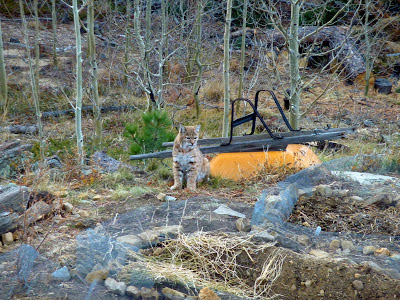We have an outdoor eating area that we carve off from our driveway in the summer months. In order not to feel as though we are sitting in the driveway, I encircle the area with large pots of container plants. After much trial and error, I have come to three conclusions about container plants for the mountains: they have to be critter resistant (anyone else found petunias to be chipmunk candy?), they have to attract hummingbirds (okay, that's my personal bias), and they have to not require too much heat to bloom (Annual salvias don't usually do well for me).
So, what are the plants I rely on?
Geraniums -- I keep them in pots, and bring them outdoors in the summer. Their colors dazzle, and the critters just don't like them.
 |
| Nasturtium "Empress of India" and Cerinthe -- look for the hummer just below the Cerinthe on the left |
Nasturtiums -- gorgeous bright blooms, easy to grow from seed, a big-time hummer attractor, and they even provide edible flowers! I like to grow them in the same pot as Cerinthe, or honeybells. These dusky purple flowers are more deeply colored with our cool nights, and are also great for hummingbirds.
 |
| Sweet pea "Matucana" provides fragrance at my front door |
Sweet peas -- I start these inside at least two months before the last frost, and twine them up my porch posts. I love the delicate fragrance as I come in and out of the door.
 |
| Anagallis monellii or blue pimpernel |
Anagallis -- this is a new favorite for me; I had never grown it before, but I love the bright blue flowers, and it has done very well through both drought and lots of rain, always covered in flowers. Never needs deadheading, either. This year, I also tried a pentas and verbena (
adventures in watering these posted earlier).
Pansies have often done well for me in the past, but it all depends on the critters tastes in any one year -- this year, probably because of the drought, they decided to eat all of them, so I have none. I love Osteospermum (and they do well in our cool nights) but so do the Golden mantled ground squirrels. Lobelia is a great plant for hanging baskets.
If you want to grow plants from seed (it's cheaper that way), start them at least two months before frost, so they will have time to fill out). If you buy plants in containers, you may need to buy them early (when they are available at garden centers down below), and move them in at nights until conditions warm up. Don't put frost-tender plants such as geraniums and nasturtiums out too early, or they will freeze to death. Container plants do require more water, so if you don't have
water rights, you will want to limit or eliminate container plants from your repetoire.











































